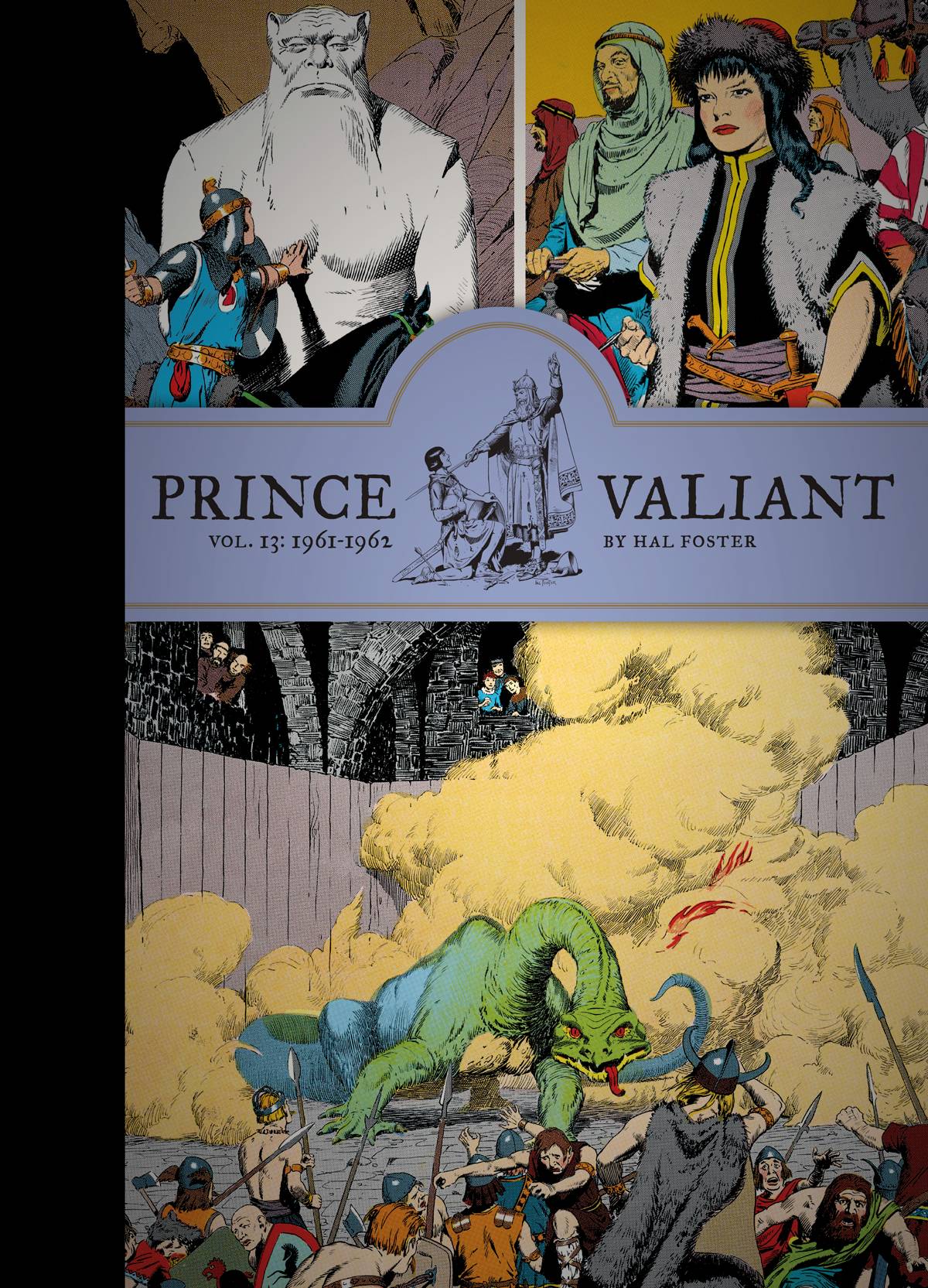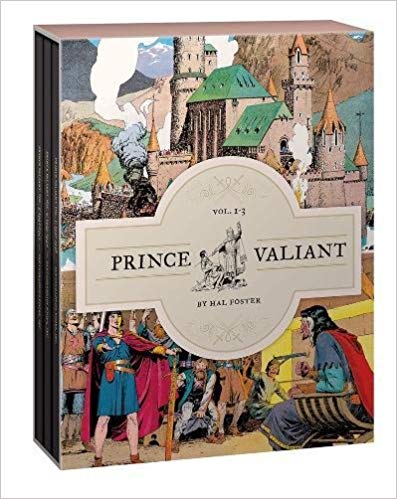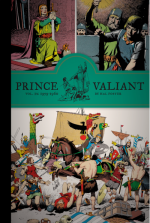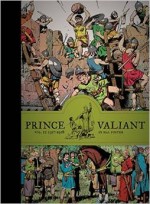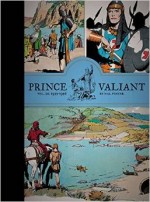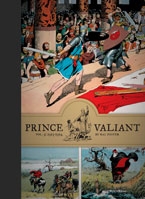


By Hal Foster (Fantagraphics Books)
ISBN: 978-1-60699-970-7 (HB)
Prince Valiant in the Days of King Arthur premiered on Sunday February 13th 1937: a fabulous rainbow-colour weekly peek into a world where history met myth to produce something greater than both. Pioneering creator Hal Foster developed the feature after a groundbreaking and astoundingly popular run on the Tarzan of the Apes comic strip.
Prince Valiant offered action, adventure, exoticism, romance and a surprisingly high quota of laughs in its engrossing depiction of noble knights and wicked barbarians played out against a glamorised, dramatized Dark Ages backdrop. The never-ending story follows a refugee lad of royal blood, driven from ancestral Scandinavian homeland Thule who grows up to roam the world, attaining a paramount position amongst the fabled heroes of Camelot.
Foster wove his complex epic romance over decades, tracing the progress of a feral wild boy who became a paragon of chivalric virtue: knight, warrior, saviour, avenger and ultimately family patriarch through a constant storm of wild, robust and joyously witty wonderment. The restless champion visited many far-flung lands, siring a dynasty of equally puissant heroes, enchanting generations of readers and thousands of creative types in all the arts.
The glorious epic spawned films, an animated series and all manner of toys, games, books and collections. Prince Valiant was – and remains – one of the few adventure strips to have run continuously from the thunderous 1930s to the present day (well north of 4000 episodes and still going strong) – and, even here at the end-times of newspaper strips as an art form, it continues in more than 300 American papers and via the internet.
Foster soloed on the feature until 1971 when John Cullen Murphy (Big Ben Bolt) succeeded him as illustrator whilst the originator remained as writer and designer. That ended in 1980, when he finally retired and Cullen Murphy’s daughter Mairead took over colouring and lettering whilst her brother John assumed the writer’s role.
In 2004 the senior Cullen Murphy also retired, since when the strip has soldiered on under the auspices of other extremely talented artists such as Gary Gianni, Scott Roberts and latterly Thomas Yeates & Mark Schultz.
This luxuriously oversized (362 x 264 mm) full-colour hardback (tragically, the series is still unavailable digitally) re-presents pages spanning January 6th 1963 to December 27th 1964, (individual Strips #1352 to 1455) and comes with all the regular bonus trimmings.
Comics scripting A-Lister Roger Stern (Superman; Avengers; Spider-Man; Doctor Strange; Incredible Hulk; Captain America) discusses and critically appraises the influential force of the newspaper strip on comic books in a picture packed Foreword ‘Swiping Mr. Foster: A Legacy in Four Colors’, offering many potent comparisons and shameless swipes, after which Brian M. Kane expands the argument about Valiant’s lasting influence in ‘Might for Right: A Code of Honor for Sentinels of Liberty’.
The erudite scholar returns at this tome’s close: spotlighting the glorious range of the master story teller in closing article ‘Land and Sea: Hal Foster’s Fine Art Paintings’ in a select gallery of land-and-seascapes, nature studies and illustrative tableau. Captivating as they are though, the real wonderment is, as ever, the unfolding epic that precedes them…
What Has Gone Before: following a failed and ruinous quest for the Holy Grail by the Round Table Knights, Valiant has compelled their return to Camelot and courtly duties. In the months that followed he visited the Great Tor at Glastonbury, met St Patrick and assisted a Papal mission from Rome building a cathedral there. Wars erupted and plots were foiled, and an extended familial rift with long-suffering wife Aleta was healed. A visit to Valiant’s homeland of Thule brought more combat and death and personal injury. With son Arn in tow, recuperation was concluded during a visit of the entire clan to Aleta’s ancestral kingdom in the Misty Isles, with Viking reiver Boltar escorting them to counter Mediterranean pirates and brigands…
At their destination, the family defeated a colonising invasion by rival ruler Thrasos during which the queen delivered twin daughters, to make Valiant a proud father of four. His peace was shattered when fleeing prisoners of war abducted Arn and his commoner pals Paul and Diane, forcing Valiant and Viking shipwright Gundar Harl, into frantic pursuit to prevent their being sold as slaves. By the time they caught up, Arn had already dealt with the problem…
Even with the crisis averted peace was impossible to find. When pilgrims bound for the Holy Land were shipwrecked on the Misty Isles, Val felt duty-bound to offer aid, and used his presence as escort to found a trade mission promoting the produce and wares of his island home. He also brought Arn, whose days of childhood indolence gave way to learning his place in the world…
Many rousing exploits marked their trail from Jaffa to the Dead Sea, Damascus to Baghdad before the pilgrimage ends in Aleppo where Boltar waits to ferry father and son back to a recovered and much wealthier Aleta. However, a brief period of glorious relaxation ends when King Arthur summons them to save Gaul from invading Goth hordes. With safe passage across Europe ended, England’s ruler needed his greatest hero carry a message to the Pope…
As Aleta’s forces secured a sea route to Albion, Valiant and Arn’s perilously mission drew much action but ultimately no satisfaction from the embattled Pontiff. Undaunted, Valiant devised an alternative trade route between the Holy Father and still-imperilled Christian Britain: visiting what become Spain and France, encountering a lost land where monks were guarded by monsters, dodging Goths and ousting a usurper whilst reinstating the true ruler…
By the time the scattered family are reunited in England, the country endures a new kind of assault, as a charismatic priest is manipulated by scurrilous scholar attendants/business managers to foment a religious revolution…
After cleverly ending the near-insurrection, Val rejoined his family at the site of a church under construction near the fens where he grew up. The lure of his sire’s past beguiles Arn, who explored the boggy waterways and was soon hopelessly lost. Over tense weeks, he experienced the same privations his father had, before being rescued.
Carrying huge wealth destined for Arthur’s coffers, the family thankfully took ship for Camelot, unaware that greedy, ambitious eyes were watching…
The illuminating wonders here resume with those eyes fatally blinking. Opportunistic fellow voyager Ethwald abducts Arn by subterfuge and holds him to ransom for the treasure Valiant is safeguarding for the king. Ethwald fears the knight’s prowess but feels assured a father will do nothing to endanger his heir. He grievously underestimates the murderous wiles of enraged mother Aleta…
The majority part of this two-year tome deals with the anticipation and results of a mass invasion by Angles and Saxons, but the slowly-building saga is comprised of many shorter episodes – adventures both tragic and even broadly comedic – in its ever-expanding tapestry.
After returning to Camelot, the family are feted until Valiant is again called to defend the realm. Arn meanwhile steadily advances from Page to Novice and begins official combat training. Soon he is made a Batchelor-at-Arms and, when the vassal king of Wales dies, is drawn into war.
The former Prince Cidwic hungers for fame, glory and riches, and – deploying his Welshmen and a mercenary Pictish and Caledonian warband – besieges Carlisle in an attempt to annexe Scottish territories. The city is defended by a small contingent of cavalry and engineers led by Sir Kay, but as Arthur prepares a rescue fleet to aid them, Valiant forms and leads a unit of swift-riding messengers from the Novices and Batchelors to keep lines of communication open. The youngest recruit is Arn…
When Cidwic regroups and fortifies his position, the boy plays a crucial role in supporting Kay’s forces and the would-be conqueror’s eventual downfall. As diplomacy and reconciliation take over, Arthur rewards the lad with more responsibility: befriending new King Cuddock, Cidwic’s 12-year old son. As they bond and duty grows into true friendship, the king’s uncle Ruddah seeks to frame Arn for murdering the boy king, and learns to his eternal regret that youth does not equate to stupidity…
The plot foiled, Valiant and Arn make their slow way back to Court, partaking of the many local jousts and tourneys that filled the autumn season and served to keep fighting men in peak form. As they compete they encounter a pair of impoverished, less than noble knights whose response to defeat leaves much to be desired and exposes the sordid underbelly of professional jousting…
Upon reaching Camelot, a joyous family reunion almost ends in shame and bloodshed when cunning schemer Modred attempts to traduce Aleta’s honour and reputation by trapping her and Launcelot in a compromising situation. His vile scheme exposed, the villain flees and encounters a Saxon war party infiltrating the region around the Vale of the White Horse. The long dreaded war with the invaders is starting to happen…
War-wise Arthur deems them to be scouting the land and sends his best men to observe them, with Arn and other knights-in-training as messengers. Sadly, Owen is still starry-eyed and vainglorious, and his inexperience leads to Arn’s capture. Thankfully he is sharp-witted and well-disguised: convincing the Saxons he is a son of infamous pirate Boltar, while turning his situation to England’s advantage by learning the plans of the vast invasion force marshalling overseas. Of course his actions suggest to the keenly watching rescue party that the son of valiant has turned traitor before the boy orchestrates his escape and reports back to Arthur…
Although moving to a war footing, life at Court continues largely as before and leads to personal crisis when a grand tournament intended to hone the fighting spirit of the nation’s champions sparks intrigue, and murder…
Visiting his kinsman Launcelot, Count Brecey of Brittany finds Aleta most pleasing and determines to make her his. That she is a queen with four children he can profitably marry off when he marries her is a huge additional benefit. Used to taking whatever he wants, the overprivileged coward operates through his assassin Hugo, but that deadly killer proves no match for Valiant and his mighty warhorse Arvak, and as a web of sinister schemes unravels, Brecey is forced to abduct Aleta and run for the coast. Thanks to the efforts of his victim and her hotly-pursuing spouse and first son, the Count doesn’t get far and – when caught – compounds his villainy with the worst kind of cowardice…
As summer approaches, Arthur’s preparations intensify, and the entire Court awaits news of a vast fleet of Angles, Jutes, Danes and Saxons. Tensions mount as word comes of established colonies previously defeated by and sworn to Arthur, recant their oaths of allegiance and pick up the swords they had abandoned for peace and acceptance. The lure of imminent plunder is everywhere and the King is forced to remind is noble subjects of their promises to supply fighting men when the nation needs them.
Valiant and Gawain are despatched to Cornwall where three local kings are at war with each other and “unable” to honour their word, whilst Arn travels to North Wales where his friend Cuddock is genuinely embattled, plagued by raids of marauding Scotti. He will soon discover, the raiders are sponsored by the Saxon overlord as a distracting diversion…
Whilst one Cornish ruler is steadfast and readily provides promised forces for the army, weak, ambitious and greedy Kings Grundemede and Alrick-the-Fat need a sharp lesson in realpolitik and practical conjuring (learned long ago when young Valiant was attached to the wizard Merlin) before they grudgingly comply…
Their missions successful both the Cornish and Welsh embassages return with their new reinforcements to Camelot to make final preparations for the encroaching Saxon invasion. Thanks to Arn’s prior intelligence warlord’s colonising raiders head for Badon Hill, the perfect site for Arthur’s stout defence…
This astounding clash takes seven weeks to tell, but at the end England is barred to them for generations and the victorious armies return to their own lands. Switching from epic action to wry romantic comedy, Foster then plays with his stars as Aleta and the visiting queen of Alrick-the-Fat indulge in combat matchmaking; each seeking to wed heroic Sir Charles of Cornwall to their respective noblewoman protégés. However, their escalating wiles and schemes make a catastrophic impression on Aleta’s twins Karen and Valeta, who apply what they’ve seen to their own relentless pursuit of boy-king Cuddock, recuperating from nobly-earned wounds and far too naive to endure being the subject of the girls’ first crush…
Employing the clever conceit of lost historical scrolls, the narrative jumps forward some months and resumes with Valiant’s entire family en route to the ancestral kingdom of Thule with bombastic brigand Boltar. The voyage is interrupted by news of marauders assembled by Skogul Oderson, who has united many tribes into a formidable force to ravage Thule.
As the year ends, the far northern chieftain is spectacularly beaten. He never counted on Valiant and wilderness scout Garm organising the scattered selfish homesteaders into a lethally effective guerrilla force who slowly whittle away the raider’s numerical advantage through guile, lethally inventive use of terrain and psychological warfare…
The final instalment here presages even greater adventure as Boltar’s son and Arn discuss a return to the lost continent they had visited: a land latterly dubbed “the New World.”
To Be Continued…
A mind-blowing panorama of visual passion and precision, Prince Valiant is a tremendous procession of boisterous action, exotic adventure and grand romance; blending epic fantasy with dry wit and broad humour, soap opera melodrama with dark violence. Lush, lavish and captivating lovely, it is an indisputable landmark of comics fiction and something no true fan should miss.
All comics © 2015 King Features Syndicate. All other content and properties © 2016 their respective creators or holders. This edition © 2016 Fantagraphics Books. All rights reserved.

